Healthcare Models: Comparing Biomedical, Social, and Global Health
VerifiedAdded on 2023/01/03
|13
|3272
|86
Report
AI Summary
This report delves into the comparison of various healthcare models, primarily focusing on the biomedical and social models, to understand their distinct approaches to patient satisfaction and cost management. It contrasts the biomedical model's emphasis on physical and biological aspects with the social model's focus on lifestyle and behavior. The report analyzes the differences between global and international health, examining determinants such as physical environment, health services, and income, and evaluating behavioral and biomedical risk factors. Through case studies, the report identifies key determinants influencing health outcomes and proposes mitigation strategies. It also explores the relationship between subjective and objective well-being theories, providing a comprehensive overview of healthcare models and their implications.

Running head: HEALTHCARE
Healthcare
Name of the Student
Name of the University
Author Note
Healthcare
Name of the Student
Name of the University
Author Note
Paraphrase This Document
Need a fresh take? Get an instant paraphrase of this document with our AI Paraphraser
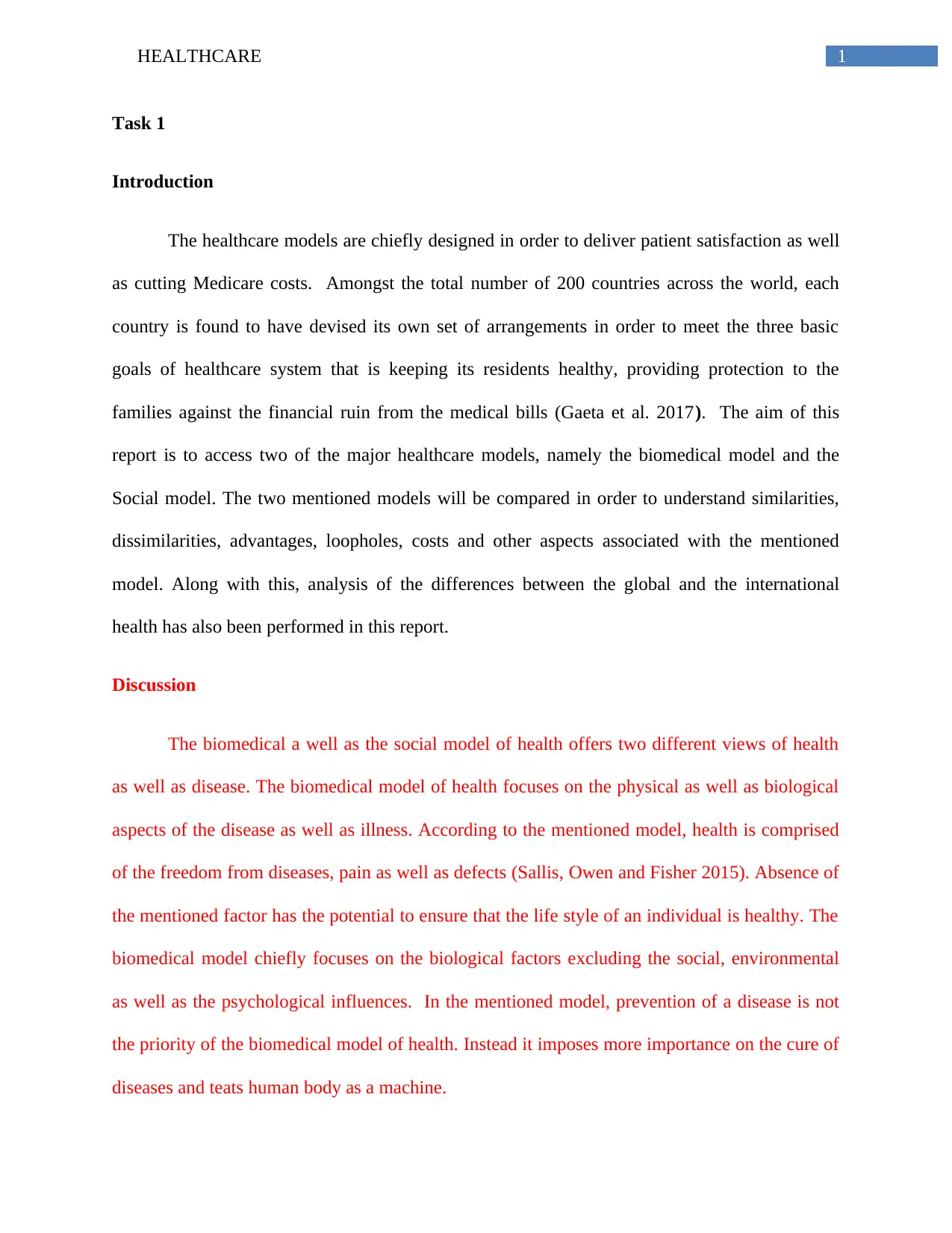
1HEALTHCARE
Task 1
Introduction
The healthcare models are chiefly designed in order to deliver patient satisfaction as well
as cutting Medicare costs. Amongst the total number of 200 countries across the world, each
country is found to have devised its own set of arrangements in order to meet the three basic
goals of healthcare system that is keeping its residents healthy, providing protection to the
families against the financial ruin from the medical bills (Gaeta et al. 2017). The aim of this
report is to access two of the major healthcare models, namely the biomedical model and the
Social model. The two mentioned models will be compared in order to understand similarities,
dissimilarities, advantages, loopholes, costs and other aspects associated with the mentioned
model. Along with this, analysis of the differences between the global and the international
health has also been performed in this report.
Discussion
The biomedical a well as the social model of health offers two different views of health
as well as disease. The biomedical model of health focuses on the physical as well as biological
aspects of the disease as well as illness. According to the mentioned model, health is comprised
of the freedom from diseases, pain as well as defects (Sallis, Owen and Fisher 2015). Absence of
the mentioned factor has the potential to ensure that the life style of an individual is healthy. The
biomedical model chiefly focuses on the biological factors excluding the social, environmental
as well as the psychological influences. In the mentioned model, prevention of a disease is not
the priority of the biomedical model of health. Instead it imposes more importance on the cure of
diseases and teats human body as a machine.
Task 1
Introduction
The healthcare models are chiefly designed in order to deliver patient satisfaction as well
as cutting Medicare costs. Amongst the total number of 200 countries across the world, each
country is found to have devised its own set of arrangements in order to meet the three basic
goals of healthcare system that is keeping its residents healthy, providing protection to the
families against the financial ruin from the medical bills (Gaeta et al. 2017). The aim of this
report is to access two of the major healthcare models, namely the biomedical model and the
Social model. The two mentioned models will be compared in order to understand similarities,
dissimilarities, advantages, loopholes, costs and other aspects associated with the mentioned
model. Along with this, analysis of the differences between the global and the international
health has also been performed in this report.
Discussion
The biomedical a well as the social model of health offers two different views of health
as well as disease. The biomedical model of health focuses on the physical as well as biological
aspects of the disease as well as illness. According to the mentioned model, health is comprised
of the freedom from diseases, pain as well as defects (Sallis, Owen and Fisher 2015). Absence of
the mentioned factor has the potential to ensure that the life style of an individual is healthy. The
biomedical model chiefly focuses on the biological factors excluding the social, environmental
as well as the psychological influences. In the mentioned model, prevention of a disease is not
the priority of the biomedical model of health. Instead it imposes more importance on the cure of
diseases and teats human body as a machine.
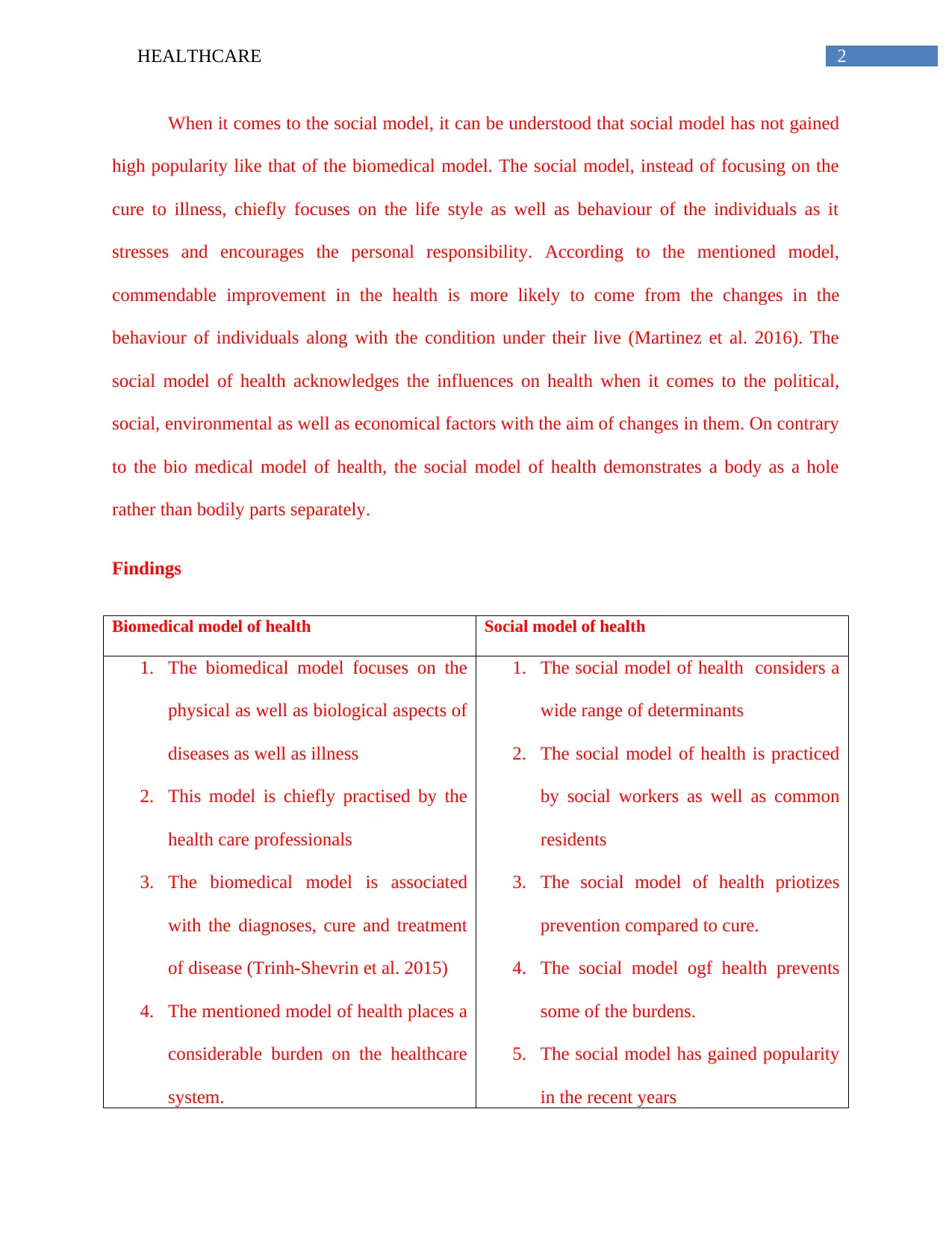
2HEALTHCARE
When it comes to the social model, it can be understood that social model has not gained
high popularity like that of the biomedical model. The social model, instead of focusing on the
cure to illness, chiefly focuses on the life style as well as behaviour of the individuals as it
stresses and encourages the personal responsibility. According to the mentioned model,
commendable improvement in the health is more likely to come from the changes in the
behaviour of individuals along with the condition under their live (Martinez et al. 2016). The
social model of health acknowledges the influences on health when it comes to the political,
social, environmental as well as economical factors with the aim of changes in them. On contrary
to the bio medical model of health, the social model of health demonstrates a body as a hole
rather than bodily parts separately.
Findings
Biomedical model of health Social model of health
1. The biomedical model focuses on the
physical as well as biological aspects of
diseases as well as illness
2. This model is chiefly practised by the
health care professionals
3. The biomedical model is associated
with the diagnoses, cure and treatment
of disease (Trinh-Shevrin et al. 2015)
4. The mentioned model of health places a
considerable burden on the healthcare
system.
1. The social model of health considers a
wide range of determinants
2. The social model of health is practiced
by social workers as well as common
residents
3. The social model of health priotizes
prevention compared to cure.
4. The social model ogf health prevents
some of the burdens.
5. The social model has gained popularity
in the recent years
When it comes to the social model, it can be understood that social model has not gained
high popularity like that of the biomedical model. The social model, instead of focusing on the
cure to illness, chiefly focuses on the life style as well as behaviour of the individuals as it
stresses and encourages the personal responsibility. According to the mentioned model,
commendable improvement in the health is more likely to come from the changes in the
behaviour of individuals along with the condition under their live (Martinez et al. 2016). The
social model of health acknowledges the influences on health when it comes to the political,
social, environmental as well as economical factors with the aim of changes in them. On contrary
to the bio medical model of health, the social model of health demonstrates a body as a hole
rather than bodily parts separately.
Findings
Biomedical model of health Social model of health
1. The biomedical model focuses on the
physical as well as biological aspects of
diseases as well as illness
2. This model is chiefly practised by the
health care professionals
3. The biomedical model is associated
with the diagnoses, cure and treatment
of disease (Trinh-Shevrin et al. 2015)
4. The mentioned model of health places a
considerable burden on the healthcare
system.
1. The social model of health considers a
wide range of determinants
2. The social model of health is practiced
by social workers as well as common
residents
3. The social model of health priotizes
prevention compared to cure.
4. The social model ogf health prevents
some of the burdens.
5. The social model has gained popularity
in the recent years
⊘ This is a preview!⊘
Do you want full access?
Subscribe today to unlock all pages.

Trusted by 1+ million students worldwide
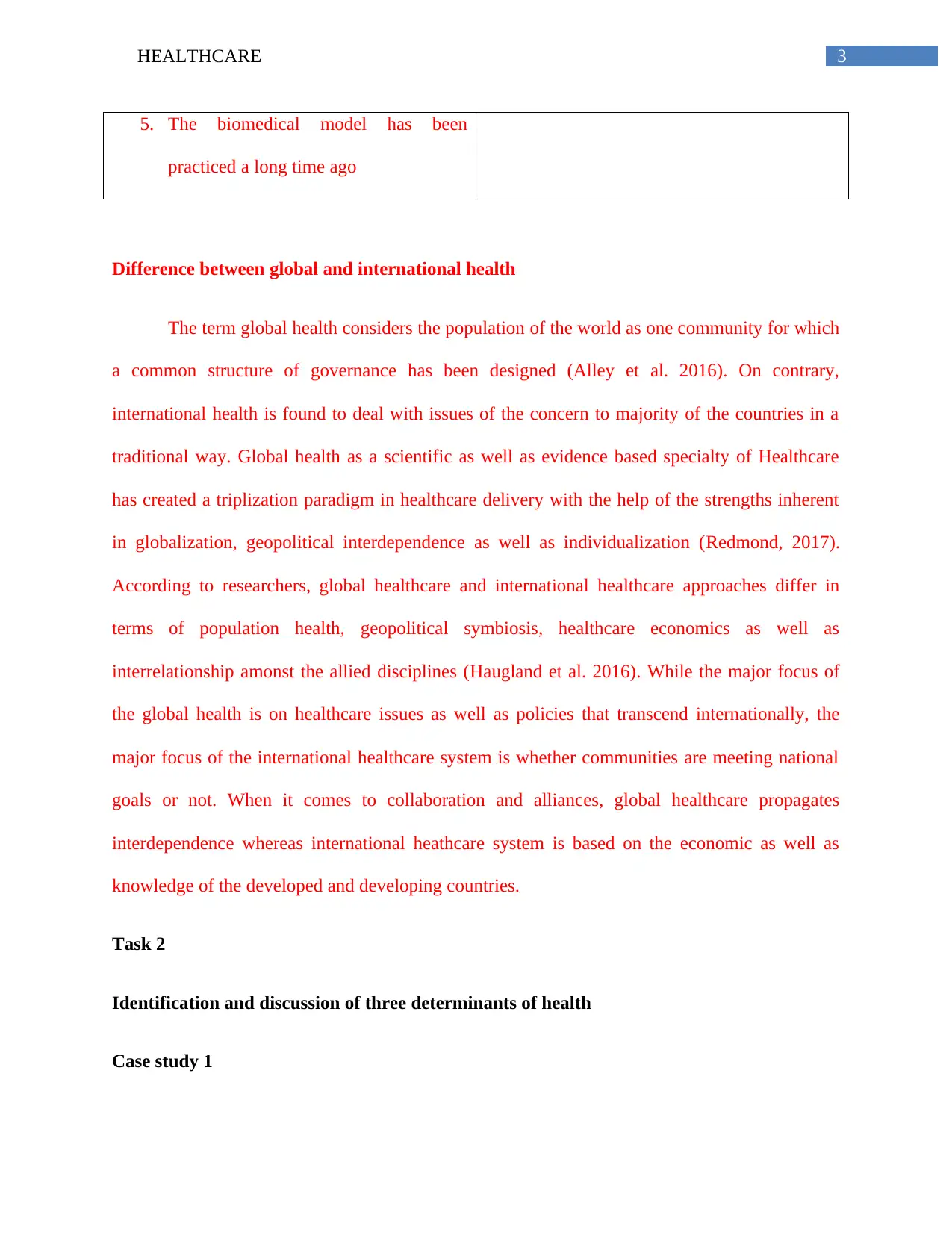
3HEALTHCARE
5. The biomedical model has been
practiced a long time ago
Difference between global and international health
The term global health considers the population of the world as one community for which
a common structure of governance has been designed (Alley et al. 2016). On contrary,
international health is found to deal with issues of the concern to majority of the countries in a
traditional way. Global health as a scientific as well as evidence based specialty of Healthcare
has created a triplization paradigm in healthcare delivery with the help of the strengths inherent
in globalization, geopolitical interdependence as well as individualization (Redmond, 2017).
According to researchers, global healthcare and international healthcare approaches differ in
terms of population health, geopolitical symbiosis, healthcare economics as well as
interrelationship amonst the allied disciplines (Haugland et al. 2016). While the major focus of
the global health is on healthcare issues as well as policies that transcend internationally, the
major focus of the international healthcare system is whether communities are meeting national
goals or not. When it comes to collaboration and alliances, global healthcare propagates
interdependence whereas international heathcare system is based on the economic as well as
knowledge of the developed and developing countries.
Task 2
Identification and discussion of three determinants of health
Case study 1
5. The biomedical model has been
practiced a long time ago
Difference between global and international health
The term global health considers the population of the world as one community for which
a common structure of governance has been designed (Alley et al. 2016). On contrary,
international health is found to deal with issues of the concern to majority of the countries in a
traditional way. Global health as a scientific as well as evidence based specialty of Healthcare
has created a triplization paradigm in healthcare delivery with the help of the strengths inherent
in globalization, geopolitical interdependence as well as individualization (Redmond, 2017).
According to researchers, global healthcare and international healthcare approaches differ in
terms of population health, geopolitical symbiosis, healthcare economics as well as
interrelationship amonst the allied disciplines (Haugland et al. 2016). While the major focus of
the global health is on healthcare issues as well as policies that transcend internationally, the
major focus of the international healthcare system is whether communities are meeting national
goals or not. When it comes to collaboration and alliances, global healthcare propagates
interdependence whereas international heathcare system is based on the economic as well as
knowledge of the developed and developing countries.
Task 2
Identification and discussion of three determinants of health
Case study 1
Paraphrase This Document
Need a fresh take? Get an instant paraphrase of this document with our AI Paraphraser
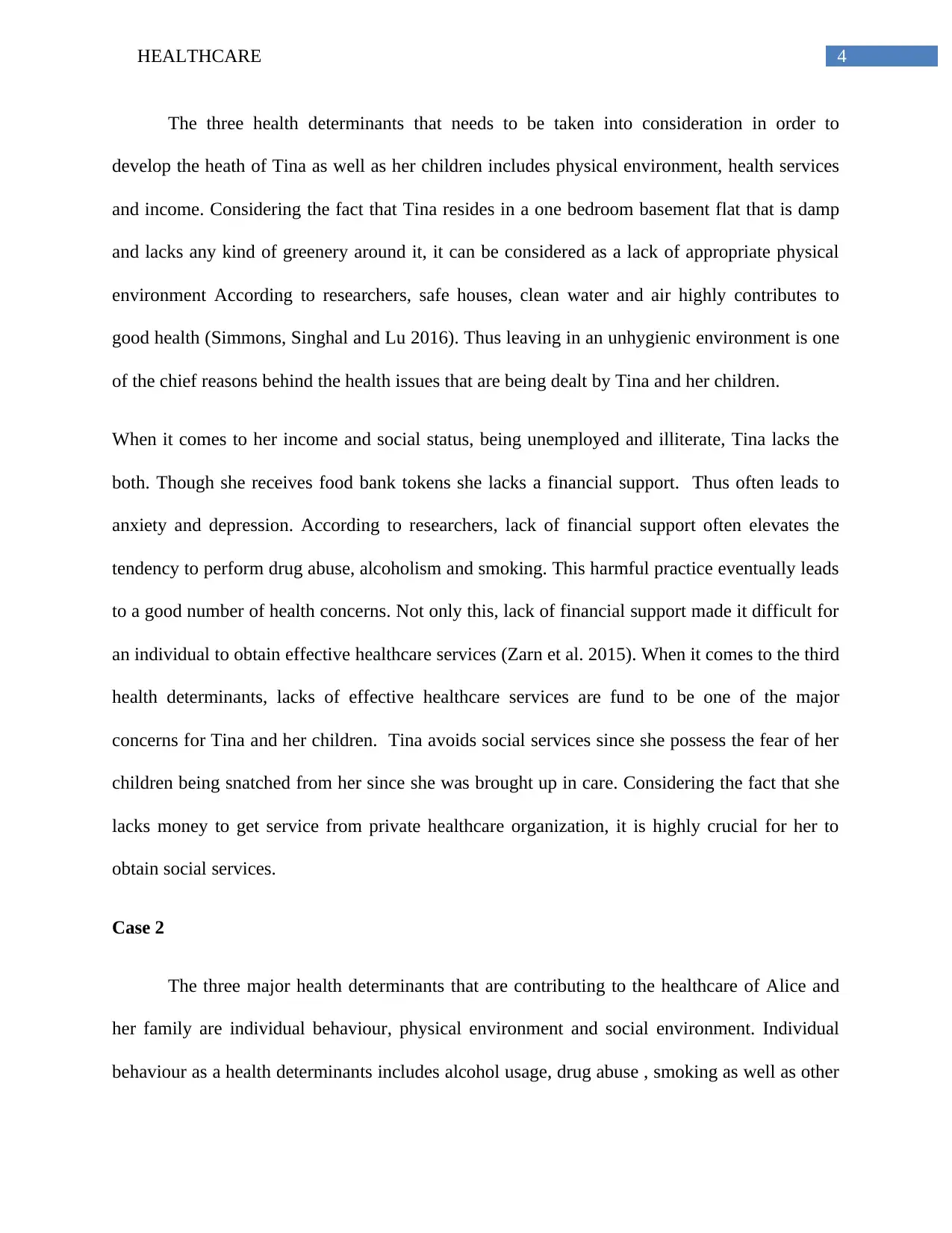
4HEALTHCARE
The three health determinants that needs to be taken into consideration in order to
develop the heath of Tina as well as her children includes physical environment, health services
and income. Considering the fact that Tina resides in a one bedroom basement flat that is damp
and lacks any kind of greenery around it, it can be considered as a lack of appropriate physical
environment According to researchers, safe houses, clean water and air highly contributes to
good health (Simmons, Singhal and Lu 2016). Thus leaving in an unhygienic environment is one
of the chief reasons behind the health issues that are being dealt by Tina and her children.
When it comes to her income and social status, being unemployed and illiterate, Tina lacks the
both. Though she receives food bank tokens she lacks a financial support. Thus often leads to
anxiety and depression. According to researchers, lack of financial support often elevates the
tendency to perform drug abuse, alcoholism and smoking. This harmful practice eventually leads
to a good number of health concerns. Not only this, lack of financial support made it difficult for
an individual to obtain effective healthcare services (Zarn et al. 2015). When it comes to the third
health determinants, lacks of effective healthcare services are fund to be one of the major
concerns for Tina and her children. Tina avoids social services since she possess the fear of her
children being snatched from her since she was brought up in care. Considering the fact that she
lacks money to get service from private healthcare organization, it is highly crucial for her to
obtain social services.
Case 2
The three major health determinants that are contributing to the healthcare of Alice and
her family are individual behaviour, physical environment and social environment. Individual
behaviour as a health determinants includes alcohol usage, drug abuse , smoking as well as other
The three health determinants that needs to be taken into consideration in order to
develop the heath of Tina as well as her children includes physical environment, health services
and income. Considering the fact that Tina resides in a one bedroom basement flat that is damp
and lacks any kind of greenery around it, it can be considered as a lack of appropriate physical
environment According to researchers, safe houses, clean water and air highly contributes to
good health (Simmons, Singhal and Lu 2016). Thus leaving in an unhygienic environment is one
of the chief reasons behind the health issues that are being dealt by Tina and her children.
When it comes to her income and social status, being unemployed and illiterate, Tina lacks the
both. Though she receives food bank tokens she lacks a financial support. Thus often leads to
anxiety and depression. According to researchers, lack of financial support often elevates the
tendency to perform drug abuse, alcoholism and smoking. This harmful practice eventually leads
to a good number of health concerns. Not only this, lack of financial support made it difficult for
an individual to obtain effective healthcare services (Zarn et al. 2015). When it comes to the third
health determinants, lacks of effective healthcare services are fund to be one of the major
concerns for Tina and her children. Tina avoids social services since she possess the fear of her
children being snatched from her since she was brought up in care. Considering the fact that she
lacks money to get service from private healthcare organization, it is highly crucial for her to
obtain social services.
Case 2
The three major health determinants that are contributing to the healthcare of Alice and
her family are individual behaviour, physical environment and social environment. Individual
behaviour as a health determinants includes alcohol usage, drug abuse , smoking as well as other
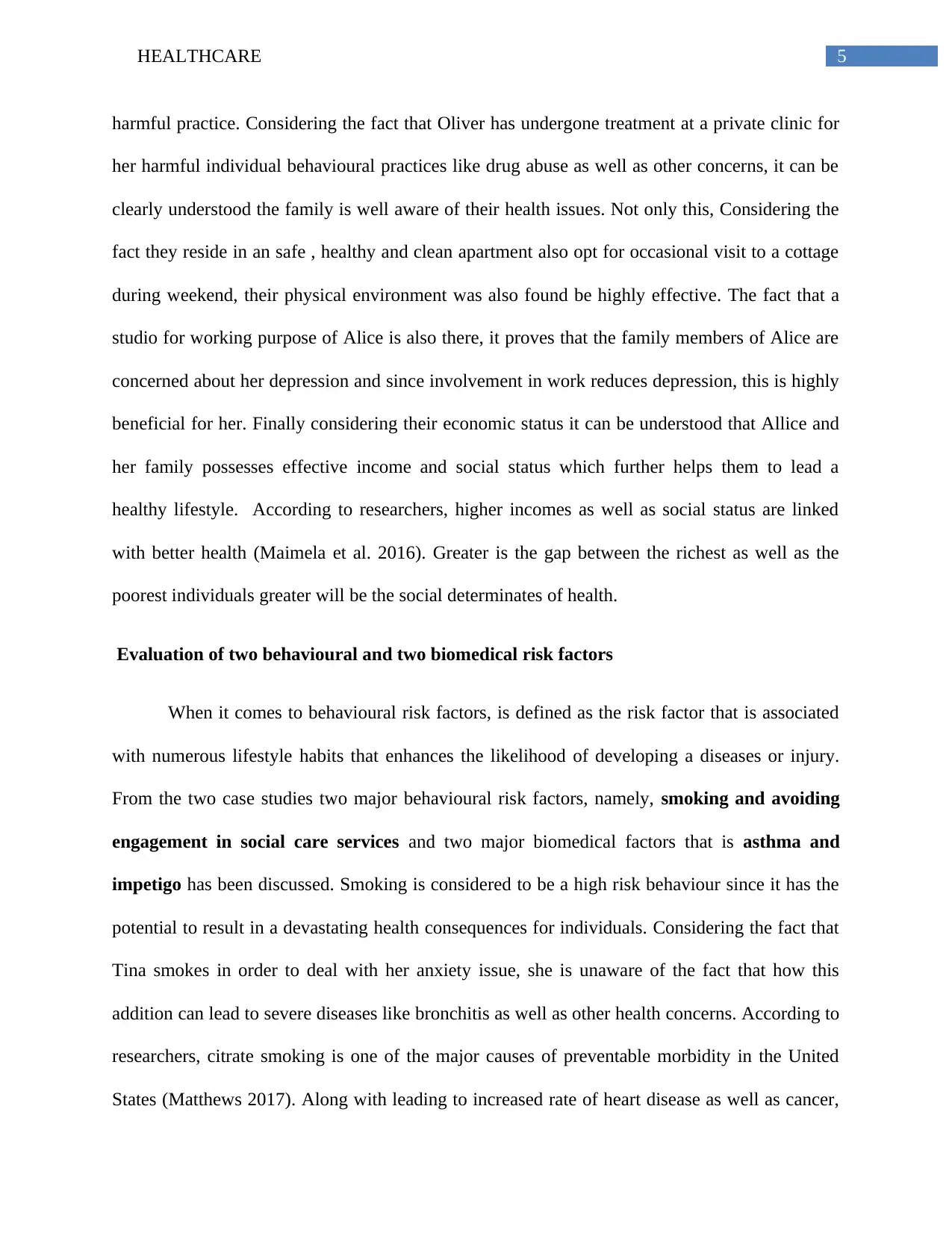
5HEALTHCARE
harmful practice. Considering the fact that Oliver has undergone treatment at a private clinic for
her harmful individual behavioural practices like drug abuse as well as other concerns, it can be
clearly understood the family is well aware of their health issues. Not only this, Considering the
fact they reside in an safe , healthy and clean apartment also opt for occasional visit to a cottage
during weekend, their physical environment was also found be highly effective. The fact that a
studio for working purpose of Alice is also there, it proves that the family members of Alice are
concerned about her depression and since involvement in work reduces depression, this is highly
beneficial for her. Finally considering their economic status it can be understood that Allice and
her family possesses effective income and social status which further helps them to lead a
healthy lifestyle. According to researchers, higher incomes as well as social status are linked
with better health (Maimela et al. 2016). Greater is the gap between the richest as well as the
poorest individuals greater will be the social determinates of health.
Evaluation of two behavioural and two biomedical risk factors
When it comes to behavioural risk factors, is defined as the risk factor that is associated
with numerous lifestyle habits that enhances the likelihood of developing a diseases or injury.
From the two case studies two major behavioural risk factors, namely, smoking and avoiding
engagement in social care services and two major biomedical factors that is asthma and
impetigo has been discussed. Smoking is considered to be a high risk behaviour since it has the
potential to result in a devastating health consequences for individuals. Considering the fact that
Tina smokes in order to deal with her anxiety issue, she is unaware of the fact that how this
addition can lead to severe diseases like bronchitis as well as other health concerns. According to
researchers, citrate smoking is one of the major causes of preventable morbidity in the United
States (Matthews 2017). Along with leading to increased rate of heart disease as well as cancer,
harmful practice. Considering the fact that Oliver has undergone treatment at a private clinic for
her harmful individual behavioural practices like drug abuse as well as other concerns, it can be
clearly understood the family is well aware of their health issues. Not only this, Considering the
fact they reside in an safe , healthy and clean apartment also opt for occasional visit to a cottage
during weekend, their physical environment was also found be highly effective. The fact that a
studio for working purpose of Alice is also there, it proves that the family members of Alice are
concerned about her depression and since involvement in work reduces depression, this is highly
beneficial for her. Finally considering their economic status it can be understood that Allice and
her family possesses effective income and social status which further helps them to lead a
healthy lifestyle. According to researchers, higher incomes as well as social status are linked
with better health (Maimela et al. 2016). Greater is the gap between the richest as well as the
poorest individuals greater will be the social determinates of health.
Evaluation of two behavioural and two biomedical risk factors
When it comes to behavioural risk factors, is defined as the risk factor that is associated
with numerous lifestyle habits that enhances the likelihood of developing a diseases or injury.
From the two case studies two major behavioural risk factors, namely, smoking and avoiding
engagement in social care services and two major biomedical factors that is asthma and
impetigo has been discussed. Smoking is considered to be a high risk behaviour since it has the
potential to result in a devastating health consequences for individuals. Considering the fact that
Tina smokes in order to deal with her anxiety issue, she is unaware of the fact that how this
addition can lead to severe diseases like bronchitis as well as other health concerns. According to
researchers, citrate smoking is one of the major causes of preventable morbidity in the United
States (Matthews 2017). Along with leading to increased rate of heart disease as well as cancer,
⊘ This is a preview!⊘
Do you want full access?
Subscribe today to unlock all pages.

Trusted by 1+ million students worldwide
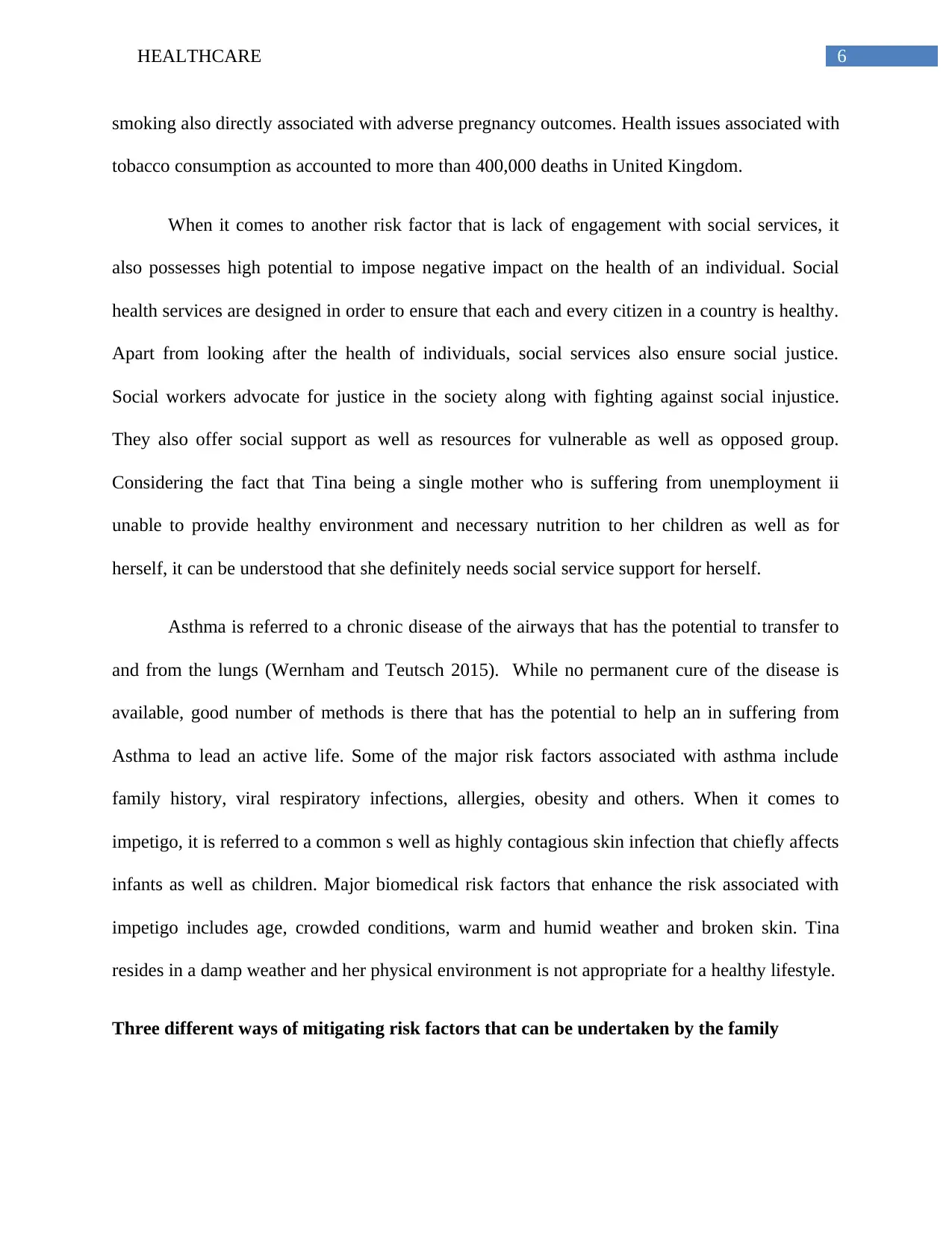
6HEALTHCARE
smoking also directly associated with adverse pregnancy outcomes. Health issues associated with
tobacco consumption as accounted to more than 400,000 deaths in United Kingdom.
When it comes to another risk factor that is lack of engagement with social services, it
also possesses high potential to impose negative impact on the health of an individual. Social
health services are designed in order to ensure that each and every citizen in a country is healthy.
Apart from looking after the health of individuals, social services also ensure social justice.
Social workers advocate for justice in the society along with fighting against social injustice.
They also offer social support as well as resources for vulnerable as well as opposed group.
Considering the fact that Tina being a single mother who is suffering from unemployment ii
unable to provide healthy environment and necessary nutrition to her children as well as for
herself, it can be understood that she definitely needs social service support for herself.
Asthma is referred to a chronic disease of the airways that has the potential to transfer to
and from the lungs (Wernham and Teutsch 2015). While no permanent cure of the disease is
available, good number of methods is there that has the potential to help an in suffering from
Asthma to lead an active life. Some of the major risk factors associated with asthma include
family history, viral respiratory infections, allergies, obesity and others. When it comes to
impetigo, it is referred to a common s well as highly contagious skin infection that chiefly affects
infants as well as children. Major biomedical risk factors that enhance the risk associated with
impetigo includes age, crowded conditions, warm and humid weather and broken skin. Tina
resides in a damp weather and her physical environment is not appropriate for a healthy lifestyle.
Three different ways of mitigating risk factors that can be undertaken by the family
smoking also directly associated with adverse pregnancy outcomes. Health issues associated with
tobacco consumption as accounted to more than 400,000 deaths in United Kingdom.
When it comes to another risk factor that is lack of engagement with social services, it
also possesses high potential to impose negative impact on the health of an individual. Social
health services are designed in order to ensure that each and every citizen in a country is healthy.
Apart from looking after the health of individuals, social services also ensure social justice.
Social workers advocate for justice in the society along with fighting against social injustice.
They also offer social support as well as resources for vulnerable as well as opposed group.
Considering the fact that Tina being a single mother who is suffering from unemployment ii
unable to provide healthy environment and necessary nutrition to her children as well as for
herself, it can be understood that she definitely needs social service support for herself.
Asthma is referred to a chronic disease of the airways that has the potential to transfer to
and from the lungs (Wernham and Teutsch 2015). While no permanent cure of the disease is
available, good number of methods is there that has the potential to help an in suffering from
Asthma to lead an active life. Some of the major risk factors associated with asthma include
family history, viral respiratory infections, allergies, obesity and others. When it comes to
impetigo, it is referred to a common s well as highly contagious skin infection that chiefly affects
infants as well as children. Major biomedical risk factors that enhance the risk associated with
impetigo includes age, crowded conditions, warm and humid weather and broken skin. Tina
resides in a damp weather and her physical environment is not appropriate for a healthy lifestyle.
Three different ways of mitigating risk factors that can be undertaken by the family
Paraphrase This Document
Need a fresh take? Get an instant paraphrase of this document with our AI Paraphraser
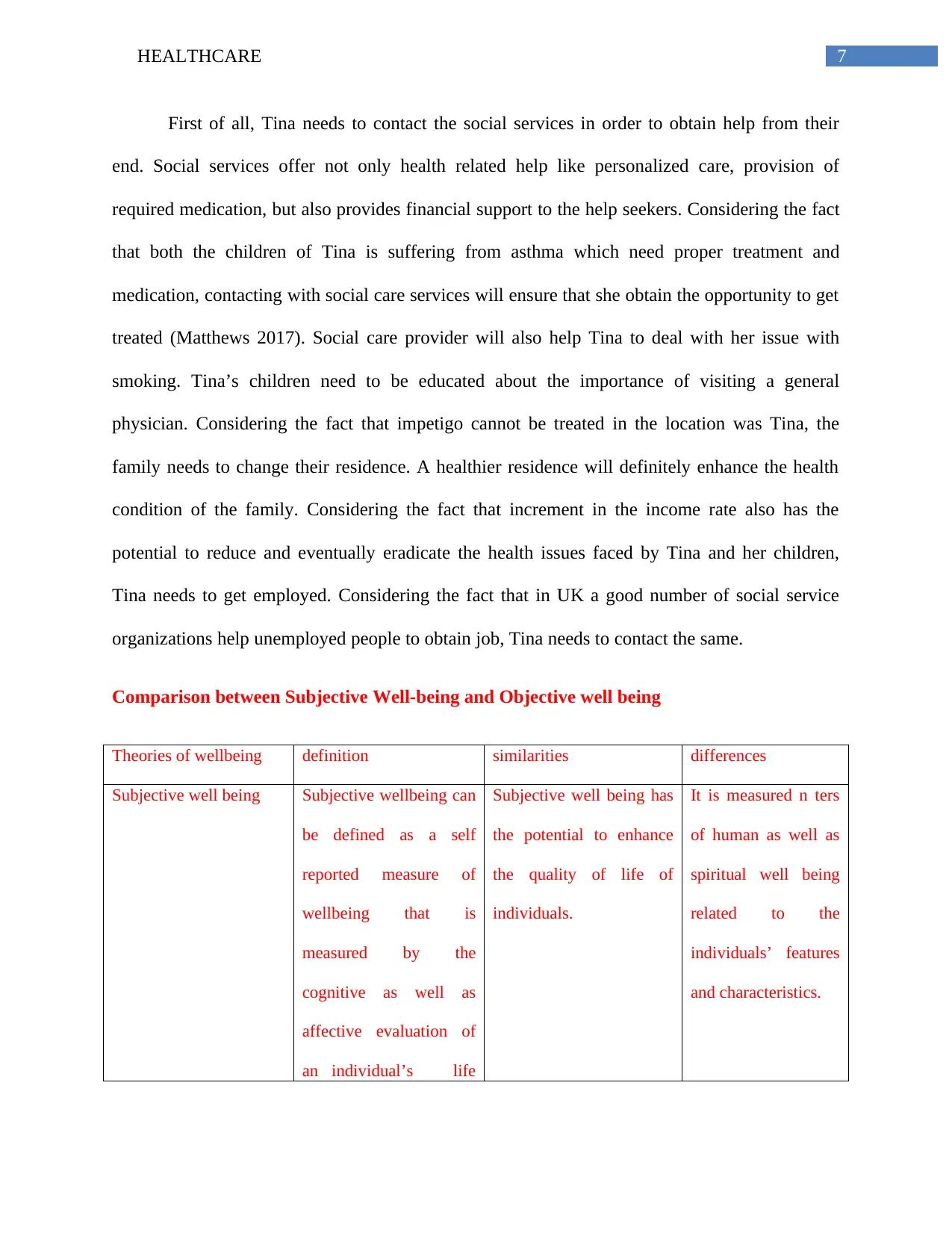
7HEALTHCARE
First of all, Tina needs to contact the social services in order to obtain help from their
end. Social services offer not only health related help like personalized care, provision of
required medication, but also provides financial support to the help seekers. Considering the fact
that both the children of Tina is suffering from asthma which need proper treatment and
medication, contacting with social care services will ensure that she obtain the opportunity to get
treated (Matthews 2017). Social care provider will also help Tina to deal with her issue with
smoking. Tina’s children need to be educated about the importance of visiting a general
physician. Considering the fact that impetigo cannot be treated in the location was Tina, the
family needs to change their residence. A healthier residence will definitely enhance the health
condition of the family. Considering the fact that increment in the income rate also has the
potential to reduce and eventually eradicate the health issues faced by Tina and her children,
Tina needs to get employed. Considering the fact that in UK a good number of social service
organizations help unemployed people to obtain job, Tina needs to contact the same.
Comparison between Subjective Well-being and Objective well being
Theories of wellbeing definition similarities differences
Subjective well being Subjective wellbeing can
be defined as a self
reported measure of
wellbeing that is
measured by the
cognitive as well as
affective evaluation of
an individual’s life
Subjective well being has
the potential to enhance
the quality of life of
individuals.
It is measured n ters
of human as well as
spiritual well being
related to the
individuals’ features
and characteristics.
First of all, Tina needs to contact the social services in order to obtain help from their
end. Social services offer not only health related help like personalized care, provision of
required medication, but also provides financial support to the help seekers. Considering the fact
that both the children of Tina is suffering from asthma which need proper treatment and
medication, contacting with social care services will ensure that she obtain the opportunity to get
treated (Matthews 2017). Social care provider will also help Tina to deal with her issue with
smoking. Tina’s children need to be educated about the importance of visiting a general
physician. Considering the fact that impetigo cannot be treated in the location was Tina, the
family needs to change their residence. A healthier residence will definitely enhance the health
condition of the family. Considering the fact that increment in the income rate also has the
potential to reduce and eventually eradicate the health issues faced by Tina and her children,
Tina needs to get employed. Considering the fact that in UK a good number of social service
organizations help unemployed people to obtain job, Tina needs to contact the same.
Comparison between Subjective Well-being and Objective well being
Theories of wellbeing definition similarities differences
Subjective well being Subjective wellbeing can
be defined as a self
reported measure of
wellbeing that is
measured by the
cognitive as well as
affective evaluation of
an individual’s life
Subjective well being has
the potential to enhance
the quality of life of
individuals.
It is measured n ters
of human as well as
spiritual well being
related to the
individuals’ features
and characteristics.
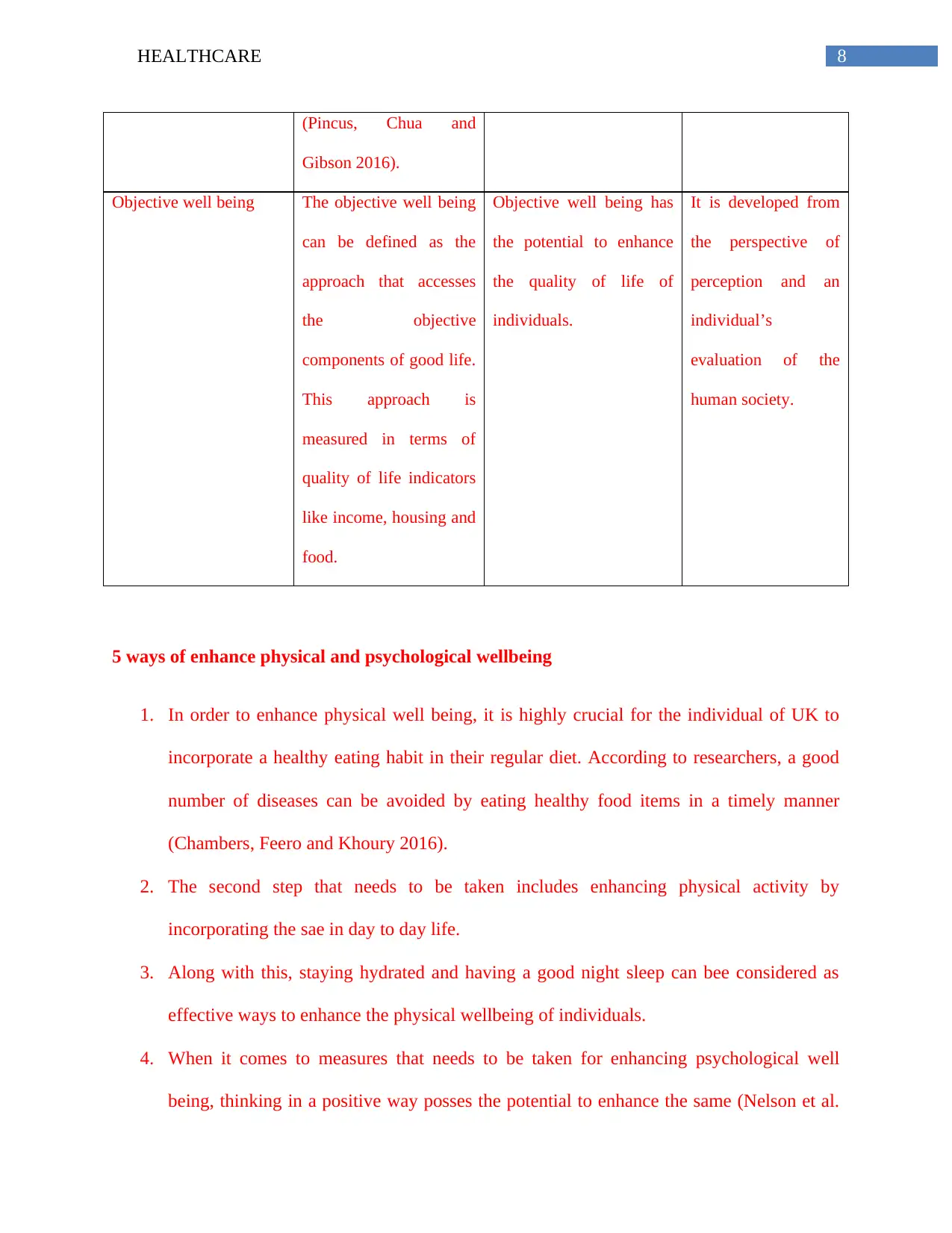
8HEALTHCARE
(Pincus, Chua and
Gibson 2016).
Objective well being The objective well being
can be defined as the
approach that accesses
the objective
components of good life.
This approach is
measured in terms of
quality of life indicators
like income, housing and
food.
Objective well being has
the potential to enhance
the quality of life of
individuals.
It is developed from
the perspective of
perception and an
individual’s
evaluation of the
human society.
5 ways of enhance physical and psychological wellbeing
1. In order to enhance physical well being, it is highly crucial for the individual of UK to
incorporate a healthy eating habit in their regular diet. According to researchers, a good
number of diseases can be avoided by eating healthy food items in a timely manner
(Chambers, Feero and Khoury 2016).
2. The second step that needs to be taken includes enhancing physical activity by
incorporating the sae in day to day life.
3. Along with this, staying hydrated and having a good night sleep can bee considered as
effective ways to enhance the physical wellbeing of individuals.
4. When it comes to measures that needs to be taken for enhancing psychological well
being, thinking in a positive way posses the potential to enhance the same (Nelson et al.
(Pincus, Chua and
Gibson 2016).
Objective well being The objective well being
can be defined as the
approach that accesses
the objective
components of good life.
This approach is
measured in terms of
quality of life indicators
like income, housing and
food.
Objective well being has
the potential to enhance
the quality of life of
individuals.
It is developed from
the perspective of
perception and an
individual’s
evaluation of the
human society.
5 ways of enhance physical and psychological wellbeing
1. In order to enhance physical well being, it is highly crucial for the individual of UK to
incorporate a healthy eating habit in their regular diet. According to researchers, a good
number of diseases can be avoided by eating healthy food items in a timely manner
(Chambers, Feero and Khoury 2016).
2. The second step that needs to be taken includes enhancing physical activity by
incorporating the sae in day to day life.
3. Along with this, staying hydrated and having a good night sleep can bee considered as
effective ways to enhance the physical wellbeing of individuals.
4. When it comes to measures that needs to be taken for enhancing psychological well
being, thinking in a positive way posses the potential to enhance the same (Nelson et al.
⊘ This is a preview!⊘
Do you want full access?
Subscribe today to unlock all pages.

Trusted by 1+ million students worldwide

9HEALTHCARE
2019). Every individual should work towards their goal and consider greater good over
personal interest in order to develop the process of positive thinking within them.
5. writing down about a better future and recalling positive life events can be considered
another effective way to enhance psychological wellbeing.
2019). Every individual should work towards their goal and consider greater good over
personal interest in order to develop the process of positive thinking within them.
5. writing down about a better future and recalling positive life events can be considered
another effective way to enhance psychological wellbeing.
Paraphrase This Document
Need a fresh take? Get an instant paraphrase of this document with our AI Paraphraser
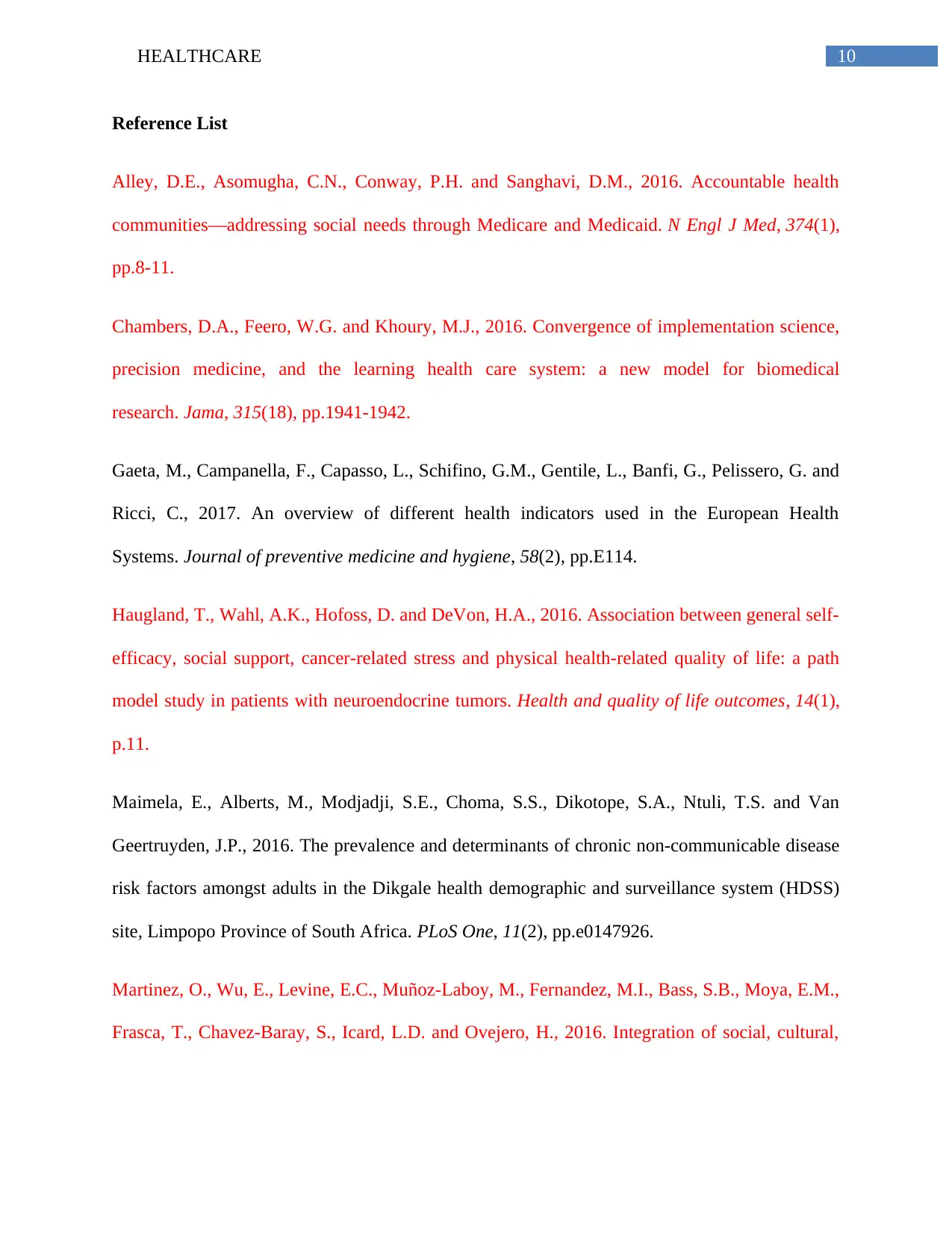
10HEALTHCARE
Reference List
Alley, D.E., Asomugha, C.N., Conway, P.H. and Sanghavi, D.M., 2016. Accountable health
communities—addressing social needs through Medicare and Medicaid. N Engl J Med, 374(1),
pp.8-11.
Chambers, D.A., Feero, W.G. and Khoury, M.J., 2016. Convergence of implementation science,
precision medicine, and the learning health care system: a new model for biomedical
research. Jama, 315(18), pp.1941-1942.
Gaeta, M., Campanella, F., Capasso, L., Schifino, G.M., Gentile, L., Banfi, G., Pelissero, G. and
Ricci, C., 2017. An overview of different health indicators used in the European Health
Systems. Journal of preventive medicine and hygiene, 58(2), pp.E114.
Haugland, T., Wahl, A.K., Hofoss, D. and DeVon, H.A., 2016. Association between general self-
efficacy, social support, cancer-related stress and physical health-related quality of life: a path
model study in patients with neuroendocrine tumors. Health and quality of life outcomes, 14(1),
p.11.
Maimela, E., Alberts, M., Modjadji, S.E., Choma, S.S., Dikotope, S.A., Ntuli, T.S. and Van
Geertruyden, J.P., 2016. The prevalence and determinants of chronic non-communicable disease
risk factors amongst adults in the Dikgale health demographic and surveillance system (HDSS)
site, Limpopo Province of South Africa. PLoS One, 11(2), pp.e0147926.
Martinez, O., Wu, E., Levine, E.C., Muñoz-Laboy, M., Fernandez, M.I., Bass, S.B., Moya, E.M.,
Frasca, T., Chavez-Baray, S., Icard, L.D. and Ovejero, H., 2016. Integration of social, cultural,
Reference List
Alley, D.E., Asomugha, C.N., Conway, P.H. and Sanghavi, D.M., 2016. Accountable health
communities—addressing social needs through Medicare and Medicaid. N Engl J Med, 374(1),
pp.8-11.
Chambers, D.A., Feero, W.G. and Khoury, M.J., 2016. Convergence of implementation science,
precision medicine, and the learning health care system: a new model for biomedical
research. Jama, 315(18), pp.1941-1942.
Gaeta, M., Campanella, F., Capasso, L., Schifino, G.M., Gentile, L., Banfi, G., Pelissero, G. and
Ricci, C., 2017. An overview of different health indicators used in the European Health
Systems. Journal of preventive medicine and hygiene, 58(2), pp.E114.
Haugland, T., Wahl, A.K., Hofoss, D. and DeVon, H.A., 2016. Association between general self-
efficacy, social support, cancer-related stress and physical health-related quality of life: a path
model study in patients with neuroendocrine tumors. Health and quality of life outcomes, 14(1),
p.11.
Maimela, E., Alberts, M., Modjadji, S.E., Choma, S.S., Dikotope, S.A., Ntuli, T.S. and Van
Geertruyden, J.P., 2016. The prevalence and determinants of chronic non-communicable disease
risk factors amongst adults in the Dikgale health demographic and surveillance system (HDSS)
site, Limpopo Province of South Africa. PLoS One, 11(2), pp.e0147926.
Martinez, O., Wu, E., Levine, E.C., Muñoz-Laboy, M., Fernandez, M.I., Bass, S.B., Moya, E.M.,
Frasca, T., Chavez-Baray, S., Icard, L.D. and Ovejero, H., 2016. Integration of social, cultural,
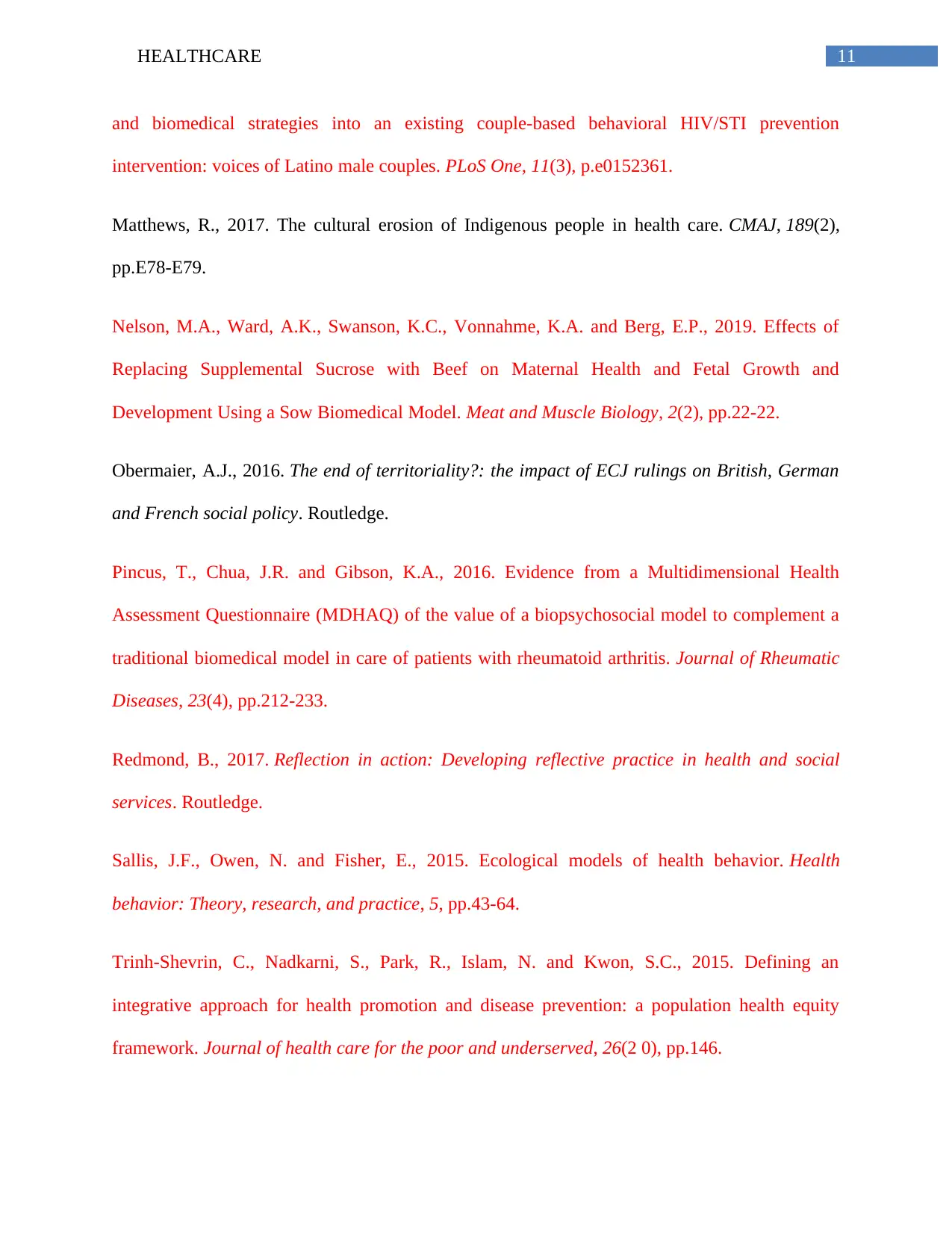
11HEALTHCARE
and biomedical strategies into an existing couple-based behavioral HIV/STI prevention
intervention: voices of Latino male couples. PLoS One, 11(3), p.e0152361.
Matthews, R., 2017. The cultural erosion of Indigenous people in health care. CMAJ, 189(2),
pp.E78-E79.
Nelson, M.A., Ward, A.K., Swanson, K.C., Vonnahme, K.A. and Berg, E.P., 2019. Effects of
Replacing Supplemental Sucrose with Beef on Maternal Health and Fetal Growth and
Development Using a Sow Biomedical Model. Meat and Muscle Biology, 2(2), pp.22-22.
Obermaier, A.J., 2016. The end of territoriality?: the impact of ECJ rulings on British, German
and French social policy. Routledge.
Pincus, T., Chua, J.R. and Gibson, K.A., 2016. Evidence from a Multidimensional Health
Assessment Questionnaire (MDHAQ) of the value of a biopsychosocial model to complement a
traditional biomedical model in care of patients with rheumatoid arthritis. Journal of Rheumatic
Diseases, 23(4), pp.212-233.
Redmond, B., 2017. Reflection in action: Developing reflective practice in health and social
services. Routledge.
Sallis, J.F., Owen, N. and Fisher, E., 2015. Ecological models of health behavior. Health
behavior: Theory, research, and practice, 5, pp.43-64.
Trinh-Shevrin, C., Nadkarni, S., Park, R., Islam, N. and Kwon, S.C., 2015. Defining an
integrative approach for health promotion and disease prevention: a population health equity
framework. Journal of health care for the poor and underserved, 26(2 0), pp.146.
and biomedical strategies into an existing couple-based behavioral HIV/STI prevention
intervention: voices of Latino male couples. PLoS One, 11(3), p.e0152361.
Matthews, R., 2017. The cultural erosion of Indigenous people in health care. CMAJ, 189(2),
pp.E78-E79.
Nelson, M.A., Ward, A.K., Swanson, K.C., Vonnahme, K.A. and Berg, E.P., 2019. Effects of
Replacing Supplemental Sucrose with Beef on Maternal Health and Fetal Growth and
Development Using a Sow Biomedical Model. Meat and Muscle Biology, 2(2), pp.22-22.
Obermaier, A.J., 2016. The end of territoriality?: the impact of ECJ rulings on British, German
and French social policy. Routledge.
Pincus, T., Chua, J.R. and Gibson, K.A., 2016. Evidence from a Multidimensional Health
Assessment Questionnaire (MDHAQ) of the value of a biopsychosocial model to complement a
traditional biomedical model in care of patients with rheumatoid arthritis. Journal of Rheumatic
Diseases, 23(4), pp.212-233.
Redmond, B., 2017. Reflection in action: Developing reflective practice in health and social
services. Routledge.
Sallis, J.F., Owen, N. and Fisher, E., 2015. Ecological models of health behavior. Health
behavior: Theory, research, and practice, 5, pp.43-64.
Trinh-Shevrin, C., Nadkarni, S., Park, R., Islam, N. and Kwon, S.C., 2015. Defining an
integrative approach for health promotion and disease prevention: a population health equity
framework. Journal of health care for the poor and underserved, 26(2 0), pp.146.
⊘ This is a preview!⊘
Do you want full access?
Subscribe today to unlock all pages.

Trusted by 1+ million students worldwide
1 out of 13
Related Documents
Your All-in-One AI-Powered Toolkit for Academic Success.
+13062052269
info@desklib.com
Available 24*7 on WhatsApp / Email
![[object Object]](/_next/static/media/star-bottom.7253800d.svg)
Unlock your academic potential
Copyright © 2020–2025 A2Z Services. All Rights Reserved. Developed and managed by ZUCOL.




